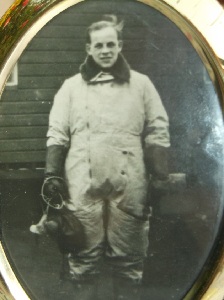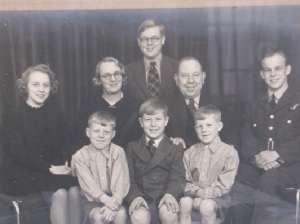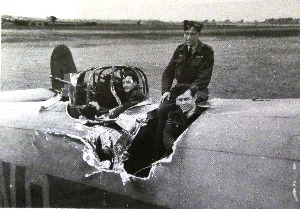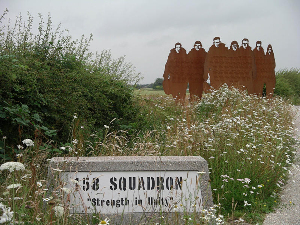
Sergeant William Walton 1104554

Family Group Photo

Halfax NP F Hit by Friendly Bombs 158 Squadron IWM
William Walton's Medals

158 Squadron Memorial
William Walton was born in Skinningrove, Cleveland in November 1921. His parents were Isabella and Earnest William Clark Walton and he was brought up in Coundon, Bishop Auckland.
William was a twin, he and his sister Elizabeth, were very small at birth and their mother kept them warm on top of the range. Their sister Christiana was born next, but she died tragically falling from a window when she was three years old. Then came Reginald (Reg, was later a choir boy in St John the Evangelist Church until he was 19 and joined up himself) and later another set of twins Donald and David.
The family lived in Chillingham, Newcastle, for a short while before moving to Killingworth at 1 West Lane (at that time the house was called Moorlands) before the beginning of World War 2. William was engaged to a beautiful young woman called Winsome Ayres from Hartlepool (the family later heard that Winsome died young but details are not known). At that time William's hobbies were body building and theatre. William used to pose for photographs for the Art College in Newcastle and hoped to go into theatre after the war.
William was called up for service in the RAF and was training on the West Coast, near Blackpool, where his family went to visit him. He was later stationed in Driffield, Yorkshire, where he flew Lancaster [sic- there were no Lancaster bombers, they were actually Halifax bombers.] William was promoted to Sergeant and was involved in the 1000 Bomber Raids. Everyone knew the raids were extremely dangerous as the planes flew in “layers” of two or three planes deep. William was killed on 14th July 1942, aged 21 years, from bombs dropped from above him by “friendly” planes in one of the bombing raids.
William's remains, along with his five crew members, were in a cemetery in Cologne before being moved and laid to rest in Reichswald Forest War Cemetery on the borders of Germany and Holland. All five crew members lie together side by side.
Reg who was nine years old when William was killed has given William's medals to his oldest son Bill, who was named after William. In recent years there were “issues” over medals as Bomber Command and Arctic Convoy soldiers were only recently awarded medals for their vital role in the war effort.
The Medals shown on the right are left to right, British War Medal 1939-1945, 1939-45 British Star and the Aircrew Europe Medal 1939-45.
William’s twin sister Elizabeth was entertaining the troops abroad when William was killed. Elizabeth came home immediately to be with her family. There is documentation that Elizabeth was mentioned in Dispatches (MiD) in 1945. Although at this time the family are unsure of the exact details, it is known that Soldiers of the British Empire or the Commonwealth of Nations who are mentioned in dispatches, but do not receive a medal for their action, are nonetheless entitled to receive a certificate and wear a decoration. Reg and his wife Ann have visited the Reichwald Forest War Cemetery on a number of occasions. On one occasion they looked in the memory book and the last entry was one word; “Frieden”-Peace.
Additional research: James Pasby
No 158(B) Squadron. Code NP. Were based at Driffield, Yorkshire (No 4 Group). Converted from Wellingtons to B Mk II Halifaxes 1942. Moved to East Moor, Yorkshire, in June 1942. Then moved to Rufforth, Yorkshire in November before moving to Lisset in February 1943.
Converted to B Mk IIIs in December 1943. No 640 (B) Squadron formed from C Flight in January 1944, and squadron strength expanded to three flights once more in March. Began conversion to B Mk VIs in April 1945, and both types used for final operational mission, against Wangerooge on 25th April 1945. Squadron reduced to two flights on 1st May 1945 and transferred to Transport Command 8th May 1945 and converted to Stirlings.
The Halifax contract for the B Mk II were initially given to Handley Page Ltd, 199 aircraft. Contract Nu 69649/37 requisition 102/E11/37 Issued for 100 Aircraft, but increased under contract 73328/40, Requisition 24/E11/39 to 199 aircraft. Deliveries started on the 13th October 1940. Other companies involved in the follow up contracts were English Electric Co Ltd (200 aircraft), London Passenger Transport Board (200 aircraft also) and Rootes Securities Ltd (150 aircraft). Plus another 200 aircraft from Handley Page Ltd.
The Bomber Command War Diary for the 14th July 1942 reads as follows:
"13/14 July 1942.
Duisburg
194 aircraft - 139 Wellingtons, 33 Halifaxes, 13 Lancasters, 9 Stirlings - on the first of a series of raids on this industrial city on the edge of the Ruhr. 6 aircraft - 3 Wellingtons, 2 Stirlings, 1 Lancaster - were lost and 4 more aircraft crashed in England.
The force encountered cloud and electrical storms and reported that their bombing was well scattered. Duisburg reports only housing damage - 11 houses destroyed, 18 seriously damaged - and 17 people killed.
Minor Operations: 10 Blenheim Intruders, 6 aircraft on leaflet flights. 1 Intruder lost."
William Walton is remembered at Killingworth on K09.01

